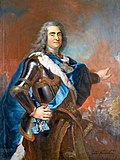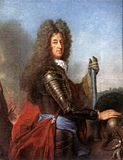Free choice (1697)
 |
||||
|
||||
|
|
||||
| Elected King of Poland and Grand Duke of Lithuania | ||||
|---|---|---|---|---|
| candidate | Friedrich August I of Saxony | François Louis de Bourbon, prince de Conti | Jakob Louis Heinrich Sobieski | |
| be right | 13,641 | |||
| candidate | Maximilian II Emanuel | Livio Odescalchi | ||
|
|
||||
The free election of 1697 was the eighth of its kind to determine the king and grand prince of the Royal Republic of the Polish Crown and the Grand Duchy of Lithuania by the nobility as a whole.
history
Johann III died on June 17, 1696 . Sobieski , King of Poland, in the Wilanów Palace near Warsaw . This meant that another free election was necessary, as the confederation of Poland-Lithuania remained without a ruler.
Candidates for the Polish throne were among others the Duke of Oława ( Lower Silesia ) and son of the late king, Jakob Louis Sobieski . The latter was initially supported by the Kingdom of France and the Swedish Empire . The nobility of Greater Poland , Lesser Poland and the Bishop of Kujawy ( Stanisław Dąmbski ) were his followers. Jakob Louis Sobieski did not get along with his French-born mother Marie Casimire Louise de la Grange d'Arquien . The mother and her son had found out about the possessions of Johann III. Sobieski quarreled, as a result of which Jakob Louis lost the support of the Polish nobility.
Another candidate was the Elector of Saxony Augustus II. , Which support from the influential and powerful Emperor Leopold I learned. In order to gain the support of the Roman Catholic, conservative Poles, August II decided to convert from Lutheranism to Catholicism. The change of faith took place on June 2, 1697 in Vienna . As a result, Frederick won the support of Pope Innocent XII.
The main opponent of the Saxon elector was François Louis de Bourbon, prince de Conti , who was supported by Louis XIV . His candidacy won the approval of several Polish and Lithuanian magnates, many of whom were bribed by the French ambassador Melchior de Polignac . On October 24, 1696, the primate Michael Radziejowski , who initially favored Jakob Louis Sobieski , changed sides and now declared his support in favor of François Louis . Since then, when Radziejowski became Interrex , his decision also had an impact on the nobility who followed him.
Nevertheless, the key role in the upcoming election was occupied by the tsarist Russia , which was the Polish ally in the ongoing war against the Ottoman Empire (see Great Turkish War ). The Russians supported August II , who had previously stated that he wanted to continue the war and commanded the Austro-Saxon army in its Hungarian campaign in 1695 and 1696. The election of François Louis would have meant a quick end to the Ottoman-Polish War, which could spark a conflict between Poland and Russia. In view of this danger, Tsarism Russia sent large amounts of money to Poland-Lithuania and tried to gain acceptance from the local nobility.
The election took place on June 27, 1697 in Wola near Warsaw , which François Louis de Bourbon, prince de Conti won, so that he became the new King of Poland and Grand Duke of Lithuania. This was immediately challenged by August II , whereupon he chose himself as the new ruler. The third candidate, Jakob Louis Sobieski, has expressed his support for François Louis .
On July 27, 1697, August II passed the Polish border near Czeladź in Lesser Poland with the support of Tsarist Russia , the Archduchy of Austria and Brandenburg-Prussia . He marched to Krakow , but he was not allowed to enter the old capital because the Starost of Krakow Franciszek Wielopolski himself was a supporter of Conti and accordingly did not allow him into the city. The stalemate was quickly resolved after Wielopolski accepted bribes. But then another problem arose. In accordance with Polish law, the coronation in the Wawel Cathedral could only be carried out with the royal insignia, which were kept in the Wawel treasury. To get into the treasury a door with eight locks would have to be opened. The keys were kept by eight senators, but six of them favored Conti . August II and his followers therefore decided to make a hole in the wall of the treasury, leaving the door untouched.
On September 15, 1697 August II signed the Pacta conventa and was crowned the new King of Poland by the Bishop of Kujawy Stanisław Dąmbski . The primate Michael Radziejowski refused to recognize the coronation, claiming that Conti was the rightful ruler. Radziejowski started the so-called Łowicz Rokosz , which gathered the supporters of the French. Conti himself, with a squadron of six ships commanded by Jean Bart , arrived on September 26, 1697 in the port of Gdansk on the Baltic Sea . Ever since Tsarist Russia concentrated its army near the Lithuanian border, an international conflict threatened to break out. The situation was resolved without foreign intervention when on November 9th of the same year the troops surrendered to August II forced Conti to leave his quarters in Oliwa and Poland. On December 12, 1697, Conti returned to France.
Primate Michael Radziejowski refused to recognize August II until the spring of 1698, after which he gave in after accepting a large amount of money and a government post.
swell
- U. Augustyniak, Historia Polski 1572–1795 , Warszawa 2008
- M. Markiewicz, Historia Polski 1494–1795 , Kraków 2002






